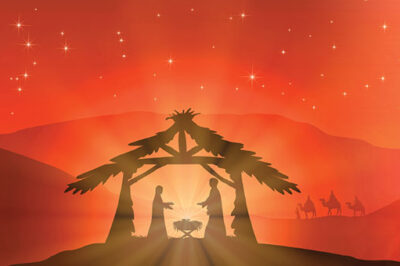The stream of tears would not stop. Standing before the plastic hospital crib, I was overcome by the magnitude of the moment. My wife had just given birth to our first child. We were now more than husband and wife; we were parents. Our little girl had come a week early, and my parents had made it just in time after almost 30 hours of airplanes, airports and the hassle of international travel.
And time began to blur. I was a baby in my parents’ arms. Now I am a father, standing before my daughter. One day she may be a mother, and we would stand beside her. Feelings I had not known before overtook me. A love and warmth cascaded over me from the heavens. I stood there in silence and wept.
For most of life, time pushes us on, clicking down the minutes, making us count the hours and the days, forcing us ahead. It presses from behind us, hurrying us past the present, making us long or dread or avoid what lies ahead. Our heads hang low, our eyes cast down, the world becoming smaller and smaller with each ticking second.
But there are moments when the heavens open up, when time’s tyranny is overthrown. Our eyes are drawn up by something we cannot always name. Standing over little Sophia that day, time stopped pushing and the sky opened up.
It isn’t just the birth of a child; all moments of beauty and wonder can have this effect. Reaching a mountain summit, catching a glimpse of a rare creature, being enveloped in a symphony’s overture, standing before a great piece of art … these are all moments that are more than moments, instances in time that are somehow beyond time, occurrences in space that somehow lift us beyond space. We are here staring at the sunset, holding a baby, embracing a lover, walking with a friend—and yet, we are somewhere else. Maybe it isn’t that these moments scramble the linear march of time and pry open the heavens. Maybe it’s just that sometimes we slow down and look up.
Under a Closed Heaven
And yet we don’t. When I meet with people, I hear about the busyness of life, the chaos of managing schedules and expectations that come cascading in from all sides. There is a mournful nostalgia in their eyes and a wistfulness in their voice as they recall the moments of wonder that once graced their lives. The truth is, I know this feeling well because it’s not just in the people I meet with; it’s in my own heart.
Where has the wonder gone? Have we forgotten how to stand in awe? What does it mean to adore?
Hauntingly, the whisper in our soul grows louder.
There was a time when worship was part of the fabric of daily life. There was a day when the question was not, “Do you worship God?” but “Which god do you worship?” or “How do we—or how should we—worship God?” But as the eminent philosopher Charles Taylor argues in his lengthy tome, A Secular Age, transcendence is no longer a “given.” It isn’t an assumed starting point; it is a contested “take” on reality. We inhabit an “immanent frame,” a sense of dwelling in a “closed” world.
Calvin College’s James K.A. Smith compares this to a football game in a dome with a retractable roof. It’s one thing to say that the roof is closed; it’s another thing to say that they were too preoccupied with the action on the field to notice the absence of the stars overhead.
So, if we have lost the sense of there being anything or anyone worthy of worship—a transcendence in its pure sense—then have we also forgotten how to worship?
“Maybe for some people,” you say. “But we, we are Christians!” Yet even for those of us who cling to transcendence in faith, who believe that there is a God in heaven whose Son came to earth and whose Spirit now dwells in us, it can be difficult to live with wonder and therefore to worship. The clutter and the noise have made us forget that there are stars up above, that there are angels singing in the heavens. Everything about our daily life is an acquiescence to a “closed roof” overhead.
Perhaps for the first time, Christians work and play and buy and sell and live in a world that presumes the absence of transcendence. Resistance is nearly impossible. We mark time in the same mundane way—by work and days off, by busyness and emptiness—and live with the same hollowness. Yes, God is “out there,” we believe; but He has become merely a providential benefactor and an end-time judge, not a “very present help in times of trouble,” and less still, Emmanuel—God with us.
So the question grows louder still: What happened to wonder? Have we forgotten how to adore?
Sacred Time
Adoration is borne of preparation. It is the culmination of a long process of cultivation, of learning to slow down, look up and bow low. And it begins with a different way of marking time, one that is in itself a resistance against time.
But we are unpracticed in this art.
From the beginning, the people of God in the Old Testament were invited to mark time in rhythmic ways. Mark morning and evening with prayer and praise and offerings, mark the seventh day for rest, mark Passover and the giving of the Law 50 days after, mark the festivals of harvest and tabernacles, and on and on it went. Life was not pushed along a line but pulled through a cycle, a rhythm of repetition with ordinary days and holy days.
Early Christians preserved this view of time but redefined it around Jesus the Messiah. Jesus became the center of time itself. Movements through the circle were movements through His life, from birth to death to resurrection and ascension. Christians re-oriented the week with Sunday—Resurrection Day!—as the new first day of the week, and began to mark key events in the life of Christ as holy days. Soon, a season of preparation before Easter developed as a way to get new converts ready for baptism. By the fourth century, Lent became a time of repentance, fasting and preparation for the whole church as they moved toward Easter. Not long after, a fast period leading up to Epiphany—the feast 12 days after Christmas—began. Advent became more formally a season of preparation for Christmas by the early seventh century, and by the ninth century, Advent was the official beginning of the church calendar. Feast days and fast days, repentance and rejoicing, year after year after year. For people who were not yet shaped by words on a page, the living rhythm of marking time by the life of Christ had the effect of centering a person on Christ and shaping Christian worship.
But we have the printed word. We have concepts and ideas and knowledge and books. Yet even with our immersion in the printed word (you’re reading this article!), we have not outgrown the power of embodied practice. What we repeatedly do shapes us. Moreover, in a community of people, what we repeatedly do together, the way we mark time together and the roads we travel together, bind us to one another and shape how we see the world.
Shaped Together
A simple example: A few summers ago, we were with my wife’s family in their hometown, a small farming community in northwest Iowa. One of our children came down with a fever and I needed to pick up some medicine from the drugstore. As I walked out of their farmhouse, I asked my mother-in-law which street the drugstore was on.
“Main Street,” she replied.
As I got in the car, I double-checked with my wife—”Main Street?”
“Yup,” she replied. Just before pulling out onto the gravel road preparing for the short five-minute drive into town, I saw my father-in-law, and he too confirmed Main Street was where I needed to go.
Yet when I got into town—home to about a thousand people and one flashing traffic light—Main Street was a street full of houses. Not one store or bank or restaurant. After a bit of driving around—I was out of cell phone coverage—I finally came to the familiar street: a row of storefronts, two banks, a library and … the drugstore. The street was actually called Reed Street, not Main Street. Yet it was the de facto Main Street because it’s where the town goes to do its main work. It’s Main Street because of how the town lives together, not because of what a town planner called the street. More to the point, my wife and her family had not learned their town by studying a map. They had learned it by inhabiting it, walking its streets, and riding bicycles and cars between there and Grandma and Grandpa’s house. The actual name of the street never occurred to them, because their communal rituals of banking, shopping and eating on Reed Street made it their Main Street.
What we repeatedly do together shapes us.
In a similar way, Christians throughout the centuries and around the world have been travelling along a path together, our Main Street. Walking it in circles, like laps around a neighborhood, has formed us into a new kind of community. More than that, it has formed us around Christ. Just as banks, libraries and grocery stores form the main street of a town, the road Christians use to mark time is oriented around the life of Christ. Sacred time, then, is a way of centering on Christ and connecting us to the body of Christ.
Sacred time is also a way of marking time that is a resistance against a world organized apart from and against God. What our culture calls Main Street is not Main Street to us at all. For example, every December, businesses decide that the malls are where we should go to offer our “sacrificial giving” in exchange for an item that promises to produce wonder. But Christians call this a sham. It’s not the real Main Street. Self-sufficiency and indulgence are not where we live and work and breathe. Christians say this is not a generic “holiday season” but authentic holy days, a sacred time of preparation for Christmas. Why? Because Jesus is the one around whom we orient time. N.T. Wright says it this way: “We are called, then, to stretch out the arms of our minds and hearts, to find ourselves, Christ shaped, cross shaped, at the intersection of the past, present and future of God’s time and our own time. … We are called to live, joyfully and painfully, in the story that is both His and ours.”
Practicing Awe
Advent marks the beginning of the liturgical year, or the church calendar, the historic Christian way of marking time. For Christmas to be a time of adoration, there must be both preparation and continuation. Christmas doesn’t come out of nowhere. It emerges out of longing and looking. And Christmas doesn’t end with Christmas; it points forward to suffering and death, and still more: to the triumph of resurrection and the ascension to the throne.
But if I gave you a list titled “Things You Should Do This Advent,” you would likely devolve into legalism. You would grit your teeth and clench your fists and determine to really do it this year, and then feel ashamed for falling short—because we all do. Spiritual practices begin with the Spirit. The practices for your home this Advent must be discerned, not decided.
So we begin by slowing down. This might mean turning down a few holiday parties this year. It may mean spending less time shopping. It might require simplifying activities and other commitments this month. Whatever it is for you, the idea is to create more space than you would normally have, more margin than you would normally live with. In short, “Let every heart prepare Him room!”
Then we practice looking up. This might be a ritual of some sort. Don’t be afraid of this word; for Christians, the power isn’t in the ritual but in the one the ritual turns us toward. Rituals simply reinforce desires and direct us to the object of that desire. Each Sunday in Advent is marked by a word or theme: Hope, Peace, Joy and Love. A simple ritual may be to light a candle on Sunday evening and reflect on how Christ brings hope, peace, joy or love into our lives. But a ritual need not be a scheduled event. It can be a posture throughout our day; or a “breath prayer” prayed frequently like Brennan Manning’s well-loved “Abba, I belong to You” or my less elegant “God, help.”
Christian spirituality has examples of both a scheduled rhythm and a habitual posture. Benedict had a “Rule of Life”—times marked for prayer and contemplation. But Ignatius of Loyola sought “contemplation in action,” a way to invite God into every moment rather than just pausing once a day in order to seek Him.
Whether your ritual is a breath prayer of awareness as you go through your day or moments to actually stop and reflect, the practice that flows out of slowing down and looking up is bowing low. The shepherds looked up and saw angels; the wise men looked up and saw a star. And their looking up led to bowing low before the Christ child.
Advent is about slowing down, looking up and bowing low. We enter the cycle of sacred time, slowing down the linear push. We look up, praying for the grace to see God at work, His kingdom arriving on earth as it is in heaven. The heavens are not closed over us. The stars shine and the angels sing. So we keep looking up. And we bow low, praying for the grace to surrender that we might, in some small way, participate in this work. We stop and make space; we listen and we lean in. Something holy is happening, even as we drive, work, rest, eat and play.
This repeated practice of looking up and bowing low is how we move slowly through the cycle of sacred time. It works like a tiller, breaking up the hard ground of our hearts, preparing us for the seeds of wonder.
And after enough time something begins to spring up from the ground: Worship. Awe. Adoration. We see, and so we sing.
In the fullness of time Christ came.
Shepherds embarked on a lengthy journey. Joseph and Mary, themselves weary from travel, stood beside these worn nomads, peering into a makeshift crib. And time lost its grip.
All the triumphs and disappointments of generations came running forward; all the hopes and future joys were being pulled into the present. The heavens lit up with angels, their songs spilling over onto earth. And those huddled around the manger slowed down, looked up and bowed low.
O come, let us adore Him.
An ordained Anglican priest, Glenn Packiam is also the lead pastor of New Life Downtown, a parish of the nondenominational, charismatic New Life Church in Colorado Springs, Colorado, where he also serves on the Executive Team. He is the author of several books and one of the founding leaders and songwriters for the Desperation Band. He is best known for writing or co-writing worship songs such as “Your Name” and “My Savior Lives.”
Glenn Packiam explains why longing is still part of the Advent season even after Jesus’ birth 2,000 years ago at packiam.charismamag.com








Leave a Comment
You must be logged in to post a comment.